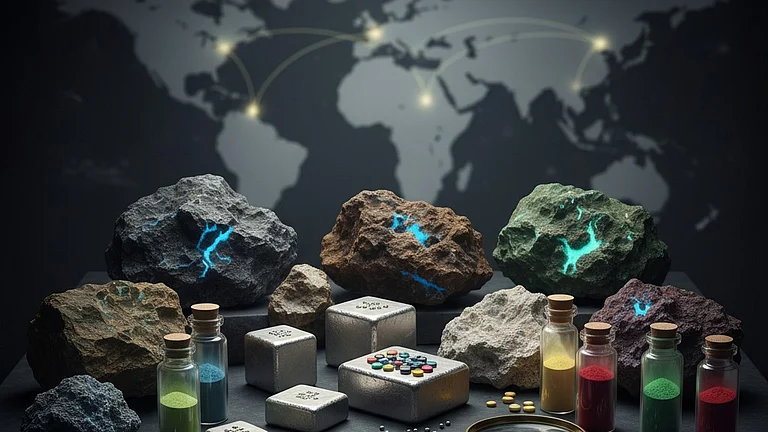China announces stricter export controls on rare earth processing technologies
Trump calls Beijing’s move “extraordinarily aggressive” and “a moral disgrace"
US plans 100% tariffs on Chinese imports and limits on critical software exports
Trump's 100% Tariffs and Rare Earth Curbs: Inside the New US–China Trade Standoff
Trade tensions between the United States and China have escalated sharply after President Donald Trump accused Beijing of taking an “extraordinarily aggressive” approach by tightening controls on rare earth exports
US President Donald Trump on October 10 accused China of taking an “extraordinarily aggressive” stance with its restrictions on rare earth minerals. He announced that the United States would respond by doubling tariffs on Chinese imports to 100% and curbing exports of critical software.
In a post on Truth Social, Trump wrote, “It has just been learned that China has taken an extraordinarily aggressive position on trade in sending an extremely hostile letter to the World, stating that they were going to, effective November 1st, 2025, impose large scale Export Controls on virtually every product they make, and some not even made by them”.
He said that the move affects all countries, without exception, and was obviously a plan devised by China years ago. Trump also said it is absolutely unheard of in international trade, while calling it a “moral disgrace in dealing with other nations”.
“…not other Nations who were similarly threatened, starting November 1st, 2025 (or sooner, depending on any further actions or changes taken by China), the United States of America will impose a Tariff of 100% on China, over and above any tariff that they are currently paying. Also on November 1st, we will impose Export Controls on any and all critical software,” he added.
Trump further stated it is impossible to believe that China would have taken such an action, but “they have, and the rest is history”.
US-China Trade Talks
Trade tensions between the world’s two largest economies have deepened amid disputes over tariffs, technology transfer, and access to vital materials. The trade agreement, if finalises, is likely to resolve long-standing trade disputes, particularly those concerning rare-earth minerals and magnets, critical for the defense and electronics industries.
The recent announcement made by Trump marks the sharpest escalation in US-China trade tensions since the original tariff war began in 2018.
Trump, while speaking to reporters at the White House, expressed doubt over the anticipated meeting with Chinese President Xi Jingping in South Korea would happen. The meeting was expected in three weeks.
However, Trump said, “Now there seems to be no reason to do so. I haven't cancelled. I would assume we might have it. Beijing has never confirmed the meeting”. Reuters stated that this marks the most significant strain in US-China relations in the past six months.
The earlier Geneva discussions had largely collapsed due to China’s export restrictions on critical minerals. In response, the Trump administration imposed its own export controls, banning the shipment of semiconductor‑design tools, aircraft and other essential products to China.
China’s New Rare Earth Restrictions
China’s Ministry of Commerce on Thursday announced a tightening of its rare earth export controls by expanding its restrictions on processing technology. The move aims to leverage Beijing’s dominance amid ongoing trade friction with Washington.
The announcement from the ministry came days before US President Donald Trump and his Chinese counterpart Xi Jinping are scheduled to meet in South Korea, on the sidelines of the Asia Pacific Economic Cooperation in the last week of October.
Under the new Chinese rule, any product containing more than 0.1% China-origin rare earths or produced using Chinese refining or magnet-making technology will require Beijing’s export approval.
With control over 70% of global rare-earth refining capacity, China has effectively weaponsed its dominance over minerals that underpin everything from F-35 fighter jets to EV motors and wind turbines.
Beijing dominates the production and export of rare earth minerals and accounts for about 60% of global mine production and 90% of global processing capacity and permanent magnet output. The country has been leveraging its dominance in the sector and been weaponising export of rare earth minerals to push back against the US’s aggressive tariff policies.
After announcing restrictive measures on rare-earth minerals in April, the latest restrictions on exporting the technology will be expanded to more types of magnets, according to reports.
Equipments used to recycle rare earths will now require a licence to export. Overseas manufacturers using any Chinese components or machinery are also required to apply for licences to export controlled items, the ministry said.
Ripple Effect of Rare Earth Limits
The United States has long relied on similar economic coercion. Since 2018, Washington has tightened export controls to deny China access to high-end chips, lithography tools, and AI software.
The most restrictive measures came in October 2022 and December 2024, when the US extended these curbs globally to cover even non-US products containing American technology. Washington also forced Japan, the Netherlands, and South Korea to impose matching restrictions—cutting China off from the world’s most advanced semiconductor supply chains.
However, think tank GTRI believes that China’s new rare earth rule flips this logic: if you restrict our chips, we can restrict your magnets. "The impact will be felt quickly".
It says that prices of EVs, wind turbines, and semiconductor parts are expected to rise, while the US will try to “friend-shore” its mineral supply chains to Australia, Vietnam, and Canada. China, meanwhile, is likely to redirect supplies toward its non-Western partners to strengthen alternative industrial networks.
Given the strategic importance of rare earths to U.S. industry, Washington may soon have little choice but to reach a new deal with Beijing. Unlike the U.S., which often acts before weighing economic consequences, China appears more deliberate and better prepared.
America still depends heavily on China for electronics, textiles, footwear, white goods, and solar panels, leaving it exposed to retaliation.
"As prices surge once the new tariffs take effect, President Trump could struggle to contain inflation and production costs. His tough-on-China strategy risks backfiring—hurting US consumers and undermining his broader economic agenda," it adds.
India's Path Amid Global Trade Shocks
For India, GTRI says that the message is clear that no trade deal with the US is ever final. The much-publicised US–China “Phase One” trade deal of 2025, which capped US tariffs at 30% and China’s at 10%, has already been overtaken by the new 100% duty order.
"India must negotiate carefully and on equal terms, ensuring reciprocity and preserving strategic autonomy. Rather than relying on shifting US promises, New Delhi should focus on building self-reliance in critical technologies and minerals, insulating its economy from future trade shocks while leveraging its neutral position to strengthen ties with both Western and BRICS economies," it recommends.
The ties between New Delhi and Washington have been reeling under severe stress after Trump doubled tariffs on Indian goods in August to a whopping 50%t, including a 25% additional duty for India's purchase of Russian crude oil.
India had described the US action as "unfair, unjustified and unreasonable". However, a phone conversation between Prime Minister Narendra Modi and Trump last month resulted in efforts by the two sides to work on a proposed trade deal.



